Reading Skills
> Smberdaxagar
14 Ways Reading Improves Your Mind and Body – Electric Literature. Homepage Sign in / Sign up Never miss a story from Electric Literature, when you sign up for Medium. Learn more Never miss a story from Electric Literature. 6 Techniques for Building Reading Skills—in Any Subject. As avid lovers of literature, teachers often find themselves wanting to impart every bit of knowledge about a well-loved text to their students.
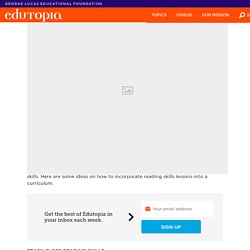
And this is not just an ELA issue—other disciplines also often focus on the content of a text. However, teaching reading skills in English classes and across the disciplines is an almost guaranteed way to help students retain content. Unfortunately, the tendency to focus on the content is a real enemy to the ultimate goal of building reading skills.
INFOGRAPHIC: How the World Reads – Electric Literature. Reading Skills. What are literacy skills?
Literacy skills help students gain knowledge through reading as well as using media and technology.
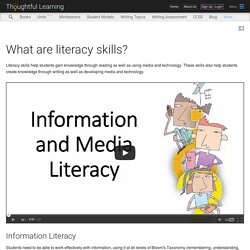
These skills also help students create knowledge through writing as well as developing media and technology. Information Literacy Students need to be able to work effectively with information, using it at all levels of Bloom's Taxonomy (remembering, understanding, applying, analyzing, evaluating, and creating). Information literacy involves traditional skills such as reading, researching, and writing; but new ways to read and write have also introduced new skills: Consuming information: The current excess of information requires students to gain new skills in handling it.
What are reading skills? –They’re not (only) what you think. Enter a caption When we talk about reading skills, what usually comes to mind?
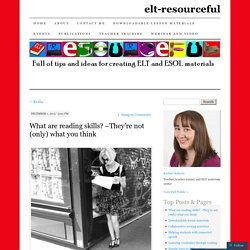
Prediction, reading for gist, reading for specific information and skimming and scanning? If you’ll forgive the clickbait style title of this post (I couldn’t resist), the fact is that there’s a lot more to the skill of reading than this. Let’s start by looking at these commonly referred to skills, and then look at what else we could (and should) be teaching our students. Prediction Students are very often encouraged to use the title of the text, or any accompanying pictures to make predictions about the content.
Reading Skills Pyramid - Put Reading First Intro. The Research Building Blocks for Teaching Children to Read Kindergarten Through Grade 3 The Research Building Blocks for Teaching Children to Read This publication was developed by the Center for the Improvement of Early Reading Achievement (CIERA) and was funded by the National Institute for Literacy (NIFL) through the Educational Research and Development Centers Program, PR/Award Number R305R70004, as administered by the Office of Educational Research and Improvement (OERI), U.S.
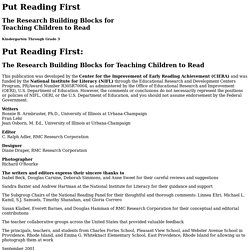
Department of Education. However, the comments or conclusions do not necessarily represent the positions or policies of NIFL, OERI, or the U.S. Writers Bonnie B.
The Lexile® Framework for Reading. Grade to Lexile Conversion Table – Newsela. Learning A-Z Level Correlation Chart. Reading skills. Reading Skills. The Framework Elements (Reading Comprehension) - The Cognitive Foundations of Learning to Read: A Framework. Effective Reading. When studying, especially at higher levels, a great deal of time is spent reading.
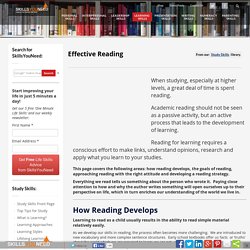
Academic reading should not be seen as a passive activity, but an active process that leads to the development of learning. Reading for learning requires a conscious effort to make links, understand opinions, research and apply what you learn to your studies. This page covers the following areas: how reading develops, the goals of reading, approaching reading with the right attitude and developing a reading strategy. Everything we read tells us something about the person who wrote it. Paying close attention to how and why the author writes something will open ourselves up to their perspective on life, which in turn enriches our understanding of the world we live in.
Untitled. Read&Write for Google Chrome. Learning Tools for OneNote. Resources from the HartResources from the Hart. I love being amazed and in awe of awesome and engaging lessons that I see teachers use in their classroom.
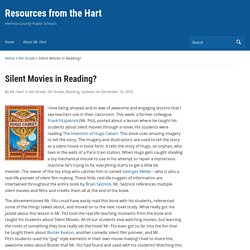
This week, a former colleague, Frank Fitzpatrick (Mr. Fitz), posted about a lesson where he taught his students about silent movies through a novel.
Reading Strategies. To go back to the task you were doing, just close this window (just make sure this is not the only window open!)
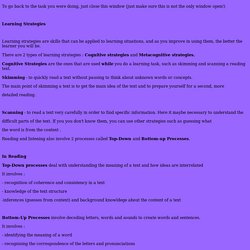
Learning Strategies Learning strategies are skills that can be applied to learning situations, and as you improve in using them, the better the learner you will be. There are 2 types of learning strategies : Cognitive strategies and Metacognitive strategies. Cognitive Strategies are the ones that are used while you do a learning task, such as skimming and scanning a reading text. Skimming - to quickly read a text without pausing to think about unknown words or concepts.
The main point of skimming a text is to get the main idea of the text and to prepare yourself for a second, more. Strategies for Developing Reading Skills. Using Reading Strategies Language instructors are often frustrated by the fact that students do not automatically transfer the strategies they use when reading in their native language to reading in a language they are learning.

Instead, they seem to think reading means starting at the beginning and going word by word, stopping to look up every unknown vocabulary item, until they reach the end. When they do this, students are relying exclusively on their linguistic knowledge, a bottom-up strategy. One of the most important functions of the language instructor, then, is to help students move past this idea and use top-down strategies as they do in their native language.
Word Search, Flashcard and Word Families. 25 Reading Strategies That Work In Every Content Area.
25 Reading Strategies That Work In Every Content Area Reading is reading.
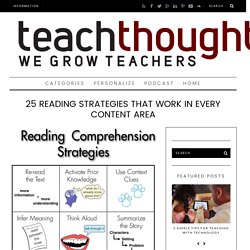
By understanding that letters make sounds, we can blend those sounds together to make whole sounds that symbolize meaning we can all exchange with one another. Without getting too Platonic about it all, reading doesn’t change simply because you’re reading a text from another content area. Only sometimes it does. Science content can often by full of jargon, research citations, and odd text features.
Social Studies content can be an interesting mix of itemized information, and traditional paragraphs/imagery.
FREE Reading Comprehension Printable Worksheets for Kids «
The Art of Interactive Reading. August 1, 2014 In Born Reading: Bringing Up Bookworms in a Digital Age, I help parents and caregivers master the art of interactive reading.
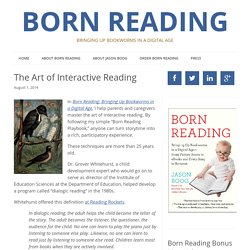
By following my simple “Born Reading Playbook,” anyone can turn storytime into a rich, participatory experience. These techniques are more than 25 years old. Dr. Grover Whitehurst, a child development expert who would go on to serve as director of the Institute of Education Sciences at the Department of Education, helped develop a program called “dialogic reading” in the 1980s.
Story Structure Lesson PowerPoint. Breaking News English Lessons: Easy English News. 6 Traits of Writing - Reading - Professional Development -Smekens. Reading Worksheets, Spelling, Grammar, Comprehension, Lesson Plans -
Text Complexity? Helping Readers See The Whole Text -
Text Complexity? Helping Readers See The Whole Text by Grant Wiggins, Authentic Education Selecting Text For Comprehension In the previous literacy posts in this series I identified a few guiding questions that stem from the research:
Book: Total Literacy Techniques: Tools to Help Students Analyze Literature and Informational Texts. 20+ Rules of Storytelling You Should Know About. Interrogating Texts -
Abracadabra. Read and Listen Along and Aloud Resources. Poetry Editor & Poetry: 10 Ways to Read a Poem. 1. Get comfy and enjoy your first reading. Relax into the experience without trying to analyze anything. 2. Read the poem again, this time aloud. Listen for the musicality. 3. 4. 5. 6. 7. 8. 9. 10.
.
© 2015, Mary Harwell Sayler has 3 books of poetry, Outside Eden and Beach Songs & Wood Chimes, published by Kelsay Books in 2014 and, in 2012, Living in the Nature Poem published by Hiraeth Press with an e-book version released in 2014.
Reading Strategies. Reading is a skill that is used in all subject areas and can greatly increase or decrease a student’s success in the classroom.
Children's Library : Free Books : Free Texts. Publisher's chromolithographed pictorial wrappers favoritefavoritefavoritefavorite ( 22 reviews ) Topics: Brothers and sisters, Orphans, Conduct of life, Education California Digital Library by Crane, Thomas, b. 1843?
; Houghton, Ellen Elizabeth, 1853-1922 texts. Reading Comprehension Passages. Reading Comprehension. Online Reading Activities. LearnEnglishTeens. Reading Comprehension Stories and Worksheets!
GRE Revised General Test: Reading Comprehension. Reading Comprehension questions are designed to test a wide range of abilities that are required in order to read and understand the kinds of prose commonly encountered in graduate school.
Free English Reading comprehension tests and exercises online. Reading Comprehension Passages and Question Sets. Rubric Gallery: List of public rubrics,Reading rubrics: RCampus. Benefits of reading. PressReader - Periódicos de alrededor del mundo.
English news and easy articles for students of English. Unfiltered.news. How to Improve Your Reading Skills.
Paired Texts and Books.
Spritz. This Test Will Tell You How Fast You Read Compared to the Rest of the U.S.
Literably: the easiest way to assess reading. Q-matrix.pdf. TEC. BiblioNasium - Kids Share Book Recommendations. Use Online Reading Logs, Find Books At Their Reading Level. Commonlit. Teacher Education Center-Lesson Plans.
Why do good readers ask themselves questions about what they have just read? (Students respond.) Right. After you have predicted and clarified, you should ask good questions about what you have read for at least two reasons. One reason is to test yourself to see if you really understand what you have read. The other reason is to identify what is important to remember in the story or the passage.
The Art of Close Reading (Part One)
The Art of Close Reading (Part Two)
The Art of Close Reading (Part Three)
In the previous two columns we introduced the idea of close reading, emphasizing the importance of the following: To read well, in addition to having the above understandings, students must be able to identify the big picture within a text, to determine the key ideas within the text early on, and to see the scaffolding that connects all the ideas within the text.
Common Core - Close Reading on Pinterest. 15 terrific resources for close reading. Snap Learning is a longtime partner and supporter of The Cornerstone, and they have sponsored this post. Though their products are not included in the roundup below as these resources are free, I encourage you to check out their Close Reading Portfolio or request a demo of the product here.
They’re a fantastic company and I believe their interactive close reading exercises are among the best on the market.
How to Study. 10 Important Tips for Successful Close Reading. Close Reading Passages, High School. Close Reading Passages, Middle School. How Does The Reading Brain Work?
Science Bulletins: How Does Reading Change the Brain?
How the brain reads…
Brain. The Reading Brain (Video)
Study Skills - Reading skills. Watch the Online Video Course Speed Reading Fundamentals. Speed Reading - Study Skills from MindTools.com. Directionality in reading comprehension, employing top-down and bottom-up strategies. TeachingEnglish. Reading and note taking skills. Practical Bottom-Up Strategies for Teaching Reading. Reading Assessment Techniques - The Cognitive Foundations of Learning to Read: A Framework. Practice Reading Tests. IELTS Reading - Skills.
CSU English Success: Reading Skills Test 1. Reading Skills for Today's Adult. Improving your reading skills. GRE Revised General Test: Reading Comprehension.










